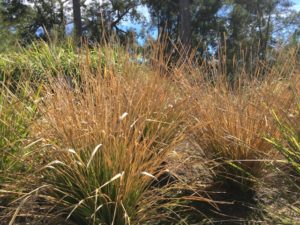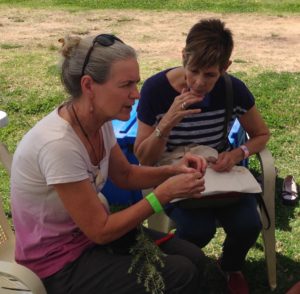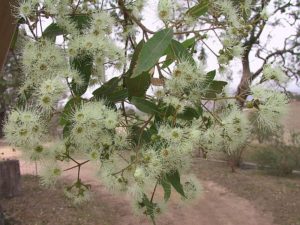
Lomandra longifolia, Summer 2017, by A Rodway
As our dams and rivers dry up, even hardy native plants like Spiny mat rush (Lomandra longifolia) are curling up their leaves. Our local Seedbank Coordinator is witnessing unusual flowering and seed set patterns in our trees and shrubs. So, as conversations abound about what a hot, dry season we’re having, let’s take a look at what the Bureau of Meteorology is saying about rainfall and temperature records for the last half year for this area and see how some of our plants are responding.
Since July 2016, rainfall on the Far South Coast of NSW has been very much below average, being in the 1st decile of records – this means it is in the lowest 10% of rainfall totals on record for this period. For this same period temperatures have been very much above average and have been in the 10th decile this means in the hottest 10% of temperatures on record for this period (based on weather data gathered from 1900 to the present). This has been exacerbated by the uneven distribution of rain across these recent months (typical for this area), with as little as 10mm in January.

Karen Walker demonstrates propagation techniques, by A Rodway
Karen Walker, Coordinator of the Far South Coast Landcare Association Community Seedbank has been collecting seed for more than 8 years in the Bega Valley and on the Monaro and has been surprised by the absence of seed set in some species and the late flowering of some plants. “Plants that I would have expected to flower and seed at particular times have had their regular patterns upset, possibly as a result of the long, cool spring followed by a hot, dry summer” said Karen.
On the Monaro, frosts were still occuring in November so plants that should have flowered in October failed to set seed and are now reflowering in an effort to reproduce. Dianella tasmanica, which is usually harvested in January, is only just flowering. Blackwood (Acacia melanoxylon) did not produce seed as expected in January.

Angophora floribunda in a better season, by J Miles & M Campbell
In the Bega Valley, there has also been no seed set on the Black wattles (Acacia mearnsii), which, down here, would usually be ready for collection in mid-December. The Rough-barked apples (Angophora floribunda) and Blackthorn/Sweet Bursaria (Bursaria spinosa) are late to flower this season. They usually flower before Christmas, but have just started flowering in the last couple of weeks, with the Angophoras flowering very sparsely. The case is similar for most of our Eucalypts which flower at this time of year. Apart from Brown barrels (Eucalyptus fastigata) on the top of the escarpment, there are very few blossoms across the Bega Valley and into the Eurobodalla.
Karen said “Plants that are trying to flower and set seed now are likely to struggle to do so due to lack of soil moisture so I’ll be relying on the seed I’ve collected and stored over the last few years when conditions were kinder”.
If you’re a landholder who needs seed for revegetation projects or advice about species selection and propagation techniques, contact Karen at the Seedbank on 0473 498 207 or email fsclaseedbank@gmail.com.
I’d love to hear from you about anything you’ve noticed in the plant or animal world in response to this season’s conditions so leave a comment here or email info@fsccmn.com.
Ali Rodway




We’re merely living on a suburban block on Long Point in Merimbula but I have noticed some differences. First of all, the lawns dying around us & then wallabies/kangaroos(I don’t know which because as hard as I try to spot them I still haven’t)coming in & eating all my roses first & then the rest of the garden except for salvias, hydrangeas & lavenders. They’ve also emptied my neighbour’s bird feeder every night as well as drunk from their bird bath. This is the first time in the 3 years since we moved here that we’ve experienced both. We’ve also had fruit bats for the first time too & I haven’t seen a micro bat at all this summer.
Hi Ali,
I’ve noticed a lot of limb fall on the forest redgums around my place. A couple of big eucs that were planted by forestry have turned up their toes in the woodlot below my place. Small gums are losing or have lost the battle to live – especially the ones that have self-sown out in the paddocks. I didn’t notice any seeding on the grasses around me this year (just withering or drying off). Cheers Kathleen McCann
Mature Bunya pines in Northeastern Victoria this year have produced up to 10 times more cones than normal but they are less than half the usual size. The unusual wet winter/spring there may have caused the increased flowering and the heat may have prevented cone development or the seed may be infertile (not known yet). These observations are by the head arborist for Indigo Shire who de-cones the trees in parks every year.